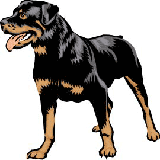Big DogsInformation About The Great Pyrenees Dog Breed |
|
|
History and origin : The Great Pyrenees is an old breed that is believed to have developed in Central Asia or Siberia and was brought to Europe by migrating Germanic tribes. Herders in the Pyrenees Mountains between France and Spain came to rely on this breed as a master herd guarder that could protect sheep, goats, and cattle from wolves and bears. The all-weather coat and huge size made him perfectly adaptable to the job and the cold climate. The Great Pyrenees is still used today to guard herds in Europe and North America. Description : The Great Pyrenees stands 25 to 32 inches at the shoulder and weighs between 90 and 125 pounds. He is heavy-bodied and strongly muscled. The coat is long and thick with a soft, dense undercoat. This breed sheds and is highly absorbent of odors. He mats easily and needs daily brushing to keep his coat in good condition. Some owners trim the coat to make grooming easier. The color is either pure white or white with gray or tan markings. About the breed : The Great Pyrenees is an independent, reserved breed that is loyal and friendly to his immediate family. He tends to be wary and suspicious of strangers and has a strong guarding instinct typical to the breed. He has been bred to work, to protect, and to defend. He is very territorial and not extremely sociable. Few breeds would be better at guarding your property and livestock than this one. Dog aggression is a real problem with Great Pyrenees, however. For a thousand years this breed was asked to protect his herds from wolves and it is hard to change that innate distrust toward canines. Training can be a challenge because he tends to be stubborn and resistant and has been known to snap when irritated. The '' Come'' command can be a difficult one to teach this breed. In addition to early training, socialization with people in various different environments is important. Take him out of his home while he is still young and let him interact with people and dogs. A Great Pyrenees may live for ten to twelve years. He can suffer from hip dysplasia, bloat, and eye infections. He may snore and drool and will eat large quantities of food. Feeding : Recommended feeding for this breed is at least 2 ½ cans (13.3oz) of high-quality meaty product with biscuit added in equal part or 5 cupfuls of a complete, dry dog food. Ideal home : This dog needs plenty of space and likes to have a job to do. Unless you have a sheep ranch, a house in the country is the best home for this breed. Keep in mind that he does not do well in a warm climate. The owner of a Great Pyrenees must be a strong, confident leader who desires a breed that will be reserved and territorial. Daily exercise is important. No nervous, spoiling, cautious, or overbearing persons should consider this breed. A job such as herding or tracking will give him purpose and will discourage restlessness and destructive behavior. The elderly and the disabled should not consider this big, powerful dog. Back to the Big Dog Breed article page
| |
|
Related News About Dogs ' ); // get rid of newsfeed display by carp CarpConf('poweredby',''); CarpCacheShow('http://classifieds.agriscape.com/syndicate/dogs.rss'); ?>
|
|
|
|
|
|
Copyright © 2006-2007 dogguidance.com |


